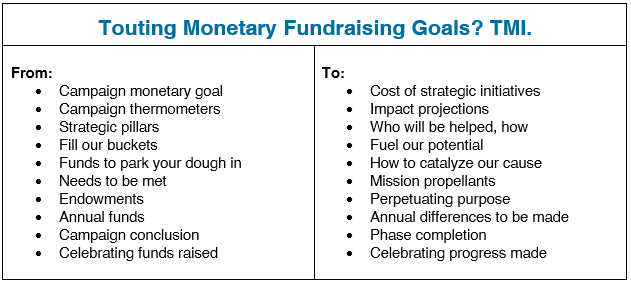“What trends are you seeing across your peer group or aspirant peers?” I asked a client team last week.
“Campaigns that play down the monetary goal and play up specific projects or initiatives,” was the consensus.
Yay! I was so thrilled to hear that.
Some of us have been pushing for this for more than a decade, for obvious reasons including:
Most donors are not the least bit motivated by monetary goals
When you crow about meeting or exceeding your monetary goals, you deaden your subsequent fundraising appeal; donors rightly ask, “Didn’t you just get everything you asked for and more?”
Monetary goals don’t provide the foundation for philanthropic partnership building, impact-delivering projects do.
Impact-delivering projects demonstrate institutional momentum and relevance.
So more and more organizational and advancement leaders have figured this out. Yay! But it applies to much more than campaigns. The same lessons should be applied to every aspect of fundraising including giving days and annual giving, which need to be much more about projected impacts for all the reasons listed above.
Once you change your mindset from “fill our buckets” to “here’s how to fuel our potential,” you become immediately more strategic and responsive and a whole new animating vocabulary unfolds as is suggested below.
You show people how to give through your organization to make significant, sustainable societal advances. You stop asking people to subsidize operations and start showing them how to optimize potential.
With a more animated, service-oriented mindset, a more enlivened vocabulary, and more concrete milestones, you put your organization in a far better position to attract new support, build philanthropic partnerships, and create a stronger community of shared purpose.

Jim Langley is the president of Langley Innovations. Langley Innovations provides a range of services to its clients to help them understand the cultural underpinnings of philanthropy and the psychology of donors and, with that knowledge, to develop the most effective strategies and tactics to build broader and more lasting communities of support. Jim has authored numerous books including his most recent book, The Future of Fundraising: Adapting to New Philanthropic Realities, published by Academic Impressions in 2020.
